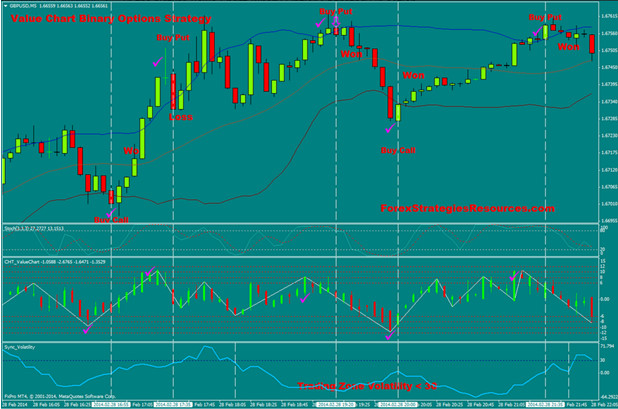Binary Options Family Values – Charts and Value Charts
Almost any new indicator that comes along intrigues people, but as more and more traders enter the scene, all indicators are new to them. To some an indicator is old, to some it’s new and is considered a virgin discovery. I’ve seen this cycle happen a lot with the Value Chart indicator and I figured it’s time we review a strategy that uses this indicator; for this I turned to forexstrategiesresources.com where I found the strategy I am going to review today.
What is the Value Chart Strategy and How to Use it
First, you should know that it uses more than one indicator so be prepared to build templates and work with a Meta Trader 4 platform (you will find a link with all indicators at the bottom of the article). The main indicator is the Value Chart, which looks like a… chart but is displayed at the bottom of your screen, in an indicator window. It acts mainly as an overbought / oversold indicator and gives a signal to Sell/Put when it goes above certain values (often determined by the user but in this case it will be +8/-8), or a signal to Buy/Call when it goes below certain values. Here it is in action (the upper levels are used for Puts and the lower levels are used for Calls):

Next we have a volatility indicator named Sync_Volatility. The author of the strategy clearly states that it doesn’t perform very well in a strong trend so he uses the volatility indicator to see if the current move is too strong. If the Sync_Volatility is above 40, he will not trade counter trend (yup, this is a counter trend strategy).
Moving on to another indicator: Bands Q with period 24, deviation 1.5. If you ask me, this is a fancy name for the Bollinger Bands but hey, don’t ask me and see for yourself instead. Anyway, whether Bands Q are Bollinger Bands or their cousin, it’s not important. What is important is that for a Call you need price to be below the lower band and for a Put you need price to be above the upper band.
The last indicator needs no introduction: Stochastic with settings 3, 3, 3. This will be our entry trigger: when it crosses upwards and all other conditions are met, we buy a Call. A downward cross will trigger a Put (all other conditions met, of course).
The rules made simple:
Call Entry:
- Sync_Volatility should be below 40
- Price is below the lower band Q
- Value Chart is above -8
- Stochastic 3, 3, 3 crosses upwards
Put Entry:
- Sync_Volatility should be below 40
- Price is above the upper Band Q
- Value Chart is below +8
- Stochastic 3, 3, 3 crosses downwards
Time frame: 5 minutes
Expiry time: 15 minutes
Currency pairs: EUR/USD, GBP/USD, AUD/USD, USD/CHF

I think it’s important to note that the Value Chart should go below -8 and then move above this level for a Call. Also, it should be above +8 and then to move below it for a Put. The author doesn’t mention this but from his pictures it’s clear he uses this rule (even if he wouldn’t, I believe it’s a good addition).
Why does Value Chart Strategy Suck?
For me it’s too complicated so I can imagine what a newbie would think of it. The rules are somewhat confusing – well, maybe not confusing but hard to grasp. Also, I have never used some of the indicators and I don’t know how good they are: Bands Q look like Bollinger Bands but I don’t know if they are better so why not use the classic and proven to work Bollinger Bands instead? That Sync_Volatility… hmmm what is that? How does it work? Wouldn’t an old fashioned ADX be more appropriate if you want to see the strength of the trend? I don’t know, but it looks to me the strategy is just a pile-up, a mash-up, a stew of indicators thrown together. Does it work? I don’t know but I wouldn’t eat that stew. Oh and something else (sorry, but I cant help it): why in the world is this called Value Chart Strategy? It could be named Stochastic Strategy (or any other of the 4 indicators) because the Value Chart is not the star of the mix.
Why the Value Chart Strategy doesn’t Suck?
Basically the strategy is making you trade Puts in overbought and Calls in oversold. Price outside upper Band Q and Value Chart above +8 means the pair is overbought and vice versa for oversold. Usually overbought / oversold trading works well when price is ranging and the author uses Sync_Volatility to gauge the condition of the market. So the idea behind it is not bad, but I just don’t think the chosen indicators can do the trick successfully.
Conclusion: Is there Any Value in the Value Chart Strategy?
Hmmm… yes, there is some value there, but it’s not something I would try on my real account. At least not before a lot of back testing and forward testing with small amounts. Also, I would change some of the indicators but I would keep the basic idea of trading overbought / oversold in a ranging market. Let me know whether or not it is good for you, keep discussing in on the Forum and give a Thanks to its creator if you make some money trading it.
Download Available: